What causes hair loss?
 |
What causes hair loss? |
Hair loss has many causes. What’s causing your hair loss can determine whether your hair:
- Falls out gradually or abruptly
- Thins
- Can regrow on its own
- Requires treatment to regrow
- Needs immediate care to prevent permanent hair loss
Causes of hair loss
Hereditary hair loss
Both men and women develop this type of hair loss, which is the most common cause of hair loss worldwide. In men, it’s called male pattern hair loss. Women get female pattern hair loss. Regardless of whether it develops in a man or women, the medical term is androgenic alopecia.No matter which term you use, it means that you’ve inherited genes that cause your hair follicles (what each hair grows out of) to shrink and eventually stop growing hair. Shrinking can begin as early as your teens, but it usually starts later in life.
In women, the first noticeable sign of hereditary hair loss is usually overall thinning or a widening part.
When a man has hereditary hair loss, the first sign is often a receding hairline or bald spot at the top of his head.
Is regrowth possible?
Hereditary hair loss
Both men and women develop
this type of hair loss, which is the most common cause of hair loss
worldwide. In men, it’s called male pattern hair loss. Women get female
pattern hair loss.
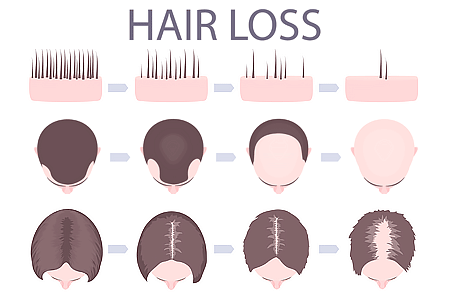
Age
With age, most people notice some hair loss because hair growth slows. At some point, hair follicles stop growing hair, which causes the hair on our scalp to thin. Hair also starts to lose its color. A woman’s hairline naturally starts to recede.Is regrowth possible?
Age
With age, most people notice some hair loss because hair growth slows.

Alopecia areata
Alopecia areata is a disease that develops when the body’s immune system attacks hair follicles (what holds the hair in place), causing hair loss. You can lose hair anywhere on your body, including your scalp, inside your nose, and in your ears. Some people lose their eyelashes or eyebrows.Is regrowth possible?
Alopecia areata
Alopecia areata is a disease
that develops when the body’s immune system attacks hair follicles (what
holds the hair in place), causing hair loss.
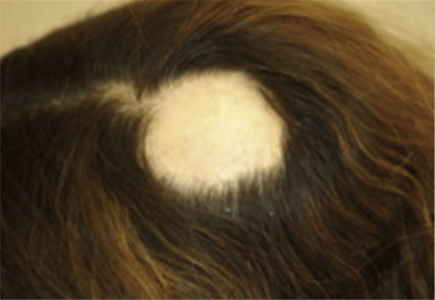
Cancer treatment
If you receive chemotherapy or have radiation treatment to your head or neck, you may lose all (or most of) your hair within a few weeks of starting treatment.Is regrowth possible?
Is it preventable?
Cancer treatment
If you receive chemotherapy
or have radiation treatment to your head or neck, you may lose all (or
most of) your hair within a few weeks of starting treatment.

Childbirth, illness, or other stressors
A few months after giving birth, recovering from an illness, or having an operation, you may notice a lot more hairs in your brush or on your pillow. This can also happen after a stressful time in your life, such as a divorce or death of a loved one.Is regrowth possible?
Childbirth, illness, or other stressors
A few months after giving
birth, recovering from an illness, or having an operation, you may
notice a lot more hairs in your brush or on your pillow. This can also
happen after a stressful time in your life, such as a divorce or death
of a loved one.
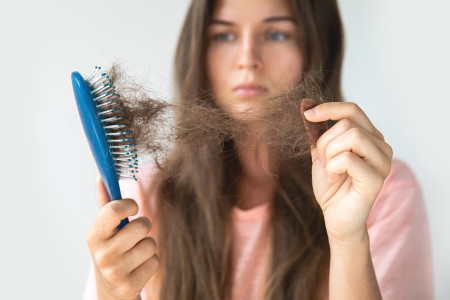
Hair care
If you color, perm, or relax your hair, you could be damaging your hair. Over time, this damage can lead to hair loss.Is regrowth possible?
Hair care
If you color, perm, or relax your hair, you could be damaging your hair. Over time, this damage can lead to hair loss.
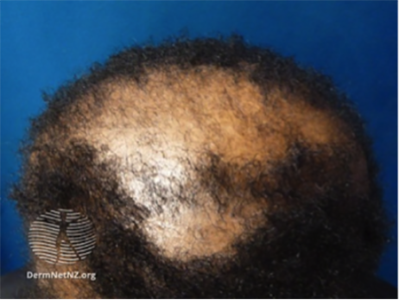
Hairstyle pulls on your scalp
If you often wear your hair tightly pulled back, the continual pulling can lead to permanent hair loss. The medical name for this condition is traction alopecia.Is regrowth possible?
Hairstyle pulls on your scalp
If you often wear your hair tightly pulled back, the continual pulling can lead to permanent hair loss.
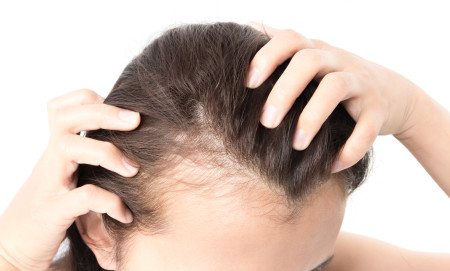
Hormonal imbalance
A common cause of this imbalance is polycystic ovary syndrome (PCOS). It leads to cysts on a woman’s ovaries, along with other signs and symptoms, which can include hair loss. Stopping some types of birth control pills can cause a temporary hormonal imbalance. Women who develop a hormonal imbalance can develop thinning hair (or hair loss) on their scalp.Is regrowth possible?
Hormonal imbalance
A common cause of this
imbalance is polycystic ovary syndrome (PCOS). It leads to cysts on a
woman’s ovaries, along with other signs and symptoms, which can include
hair loss.

Scalp infection
A scalp infection can lead to scaly and sometimes inflamed areas on your scalp. You may see what look like small black dots on your scalp. These are actually stubs of hair. Some people develop a bald spot.Is regrowth possible?
Scalp infection
A scalp infeciton can lead to scaly and sometimes inflamed areas on your scalp.
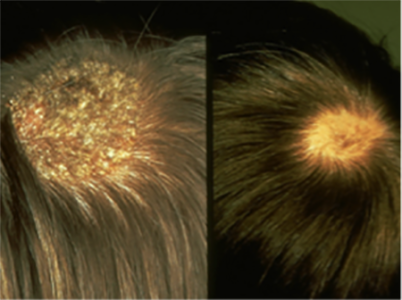
Medication
A possible side effect of some medications is hair loss. If you think a medication is causing your hair loss, ask the doctor who prescribed it if hair loss is a possible side effect. It’s essential that you do not stop taking the medication before talking with your doctor. Abruptly stopping some medications can cause serious health problems.Is regrowth possible?
Medication
A possible side effect of
some medications is hair loss. If you think a medication is causing your
hair loss, ask the doctor who prescribed it if hair loss is a possible
side effect.

Scalp psoriasis
Many people who have plaque psoriasis develop psoriasis on their scalp at some point. This can lead to hair loss.Is regrowth possible?
Scalp psoriasis
Many people who have plaque psoriasis develop psoriasis on their scalp at some point. This can lead to hair loss.

Pulling your hair
Some people pull on their hair, often to relieve stress. They may be unaware that they’re pulling their hair. The medical term for this is trichotillomania.Is regrowth possible?
Pulling your hair
Some people pull on their hair, often to relieve stress. They may be unaware that they’re pulling their hair.
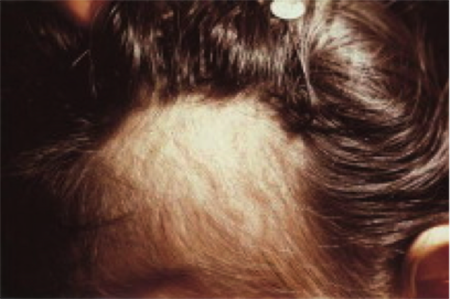
Scarring alopecia
This condition develops when inflammation destroys hair follicles. Once destroyed, a hair follicle cannot grow hair. Diverse conditions can cause this. The medical name for this group of conditions is cicatricial alopecia.Is regrowth possible?
Scarring alopecia
This condition develops when
inflammation destroys hair follicles. Once destroyed, a hair follicle
cannot grow hair. Diverse conditions can cause this.
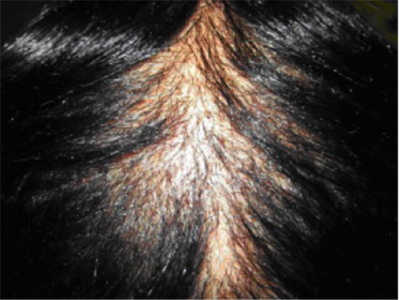
Sexually transmitted infection
Left untreated, a sexually transmitted infection (STI) can lead to hair loss. Syphilis is such an STI. Left untreted, syphilis can cause patchy hair loss on the scalp, eyebrows, beard, and elsewhere. Other STIs can also cause hair loss.Is regrowth possible?
Sexually transmitted infection
Left untreated, a sexually transmitted infection (STI) can lead to hair loss.
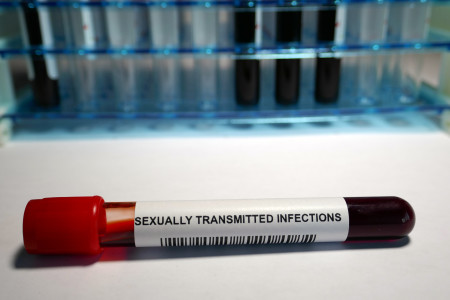
Thyroid disease
If you have a problem with your thyroid, you may see thinning hair. Some people notice that their hair comes out in clumps when they brush it.Is regrowth possible?
Thyroid disease
If you have a problem with your thyroid, you may see thinning hair.

Too little biotin, iron, protein, or zinc
If you’re not getting enough of one or more of these, you can have noticeable hair loss.Is regrowth possible?
Too little biotin, iron, protein, or zinc
If you’re not getting enough of one or more of these, you can have noticeable hair loss.
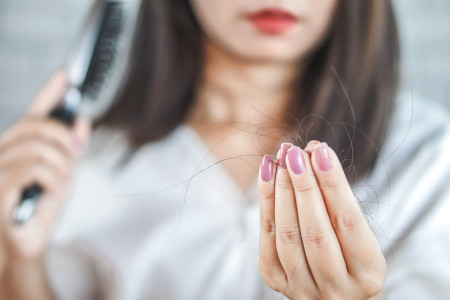
Friction
People can develop hair loss where boots, socks, or tight clothing frequently rubs against their skin. The medical term for this is frictional alopecia.Is regrowth possible?
Friction
People can develop hair loss where boots, socks, or tight clothing frequently rubs against their skin.

Poison
Being slowly poisoned can lead to hair loss. Poisons that can cause hair loss include arsenic, thallium, mercury, and lithium. If you ingest a large amount of warfarin, which is found in rat poisons, it can also cause hair loss. Taking large amounts of vitamin A or selenium is also toxic and can cause hair loss.Is regrowth possible?
Poison
Being slowly poisoned can
lead to hair loss. Poisons that can cause hair loss include arsenic,
thallium, mercury, and lithium. If you ingest a large amount of
warfarin, which is found in rat poisons, it can also cause hair loss.
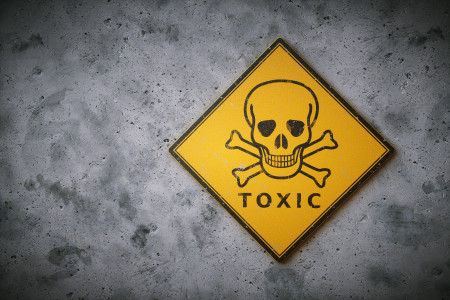
Images
1a,1b, 2,4,5,7,8,10,14,15,16,17,18: Getty Images
3, 9: Images used with permission of the American Academy of Dermatology National Library of Dermatologic Teaching Slides.
6, 11: Images used with permission of DermNet NZ.
12, 13: Images used with permission of Journal of the American Academy of Dermatology:
- J Am Acad Dermatol. 2002;46:807-21
- J Am Acad Dermatol. 2009;60:660-8.
Comments: 0